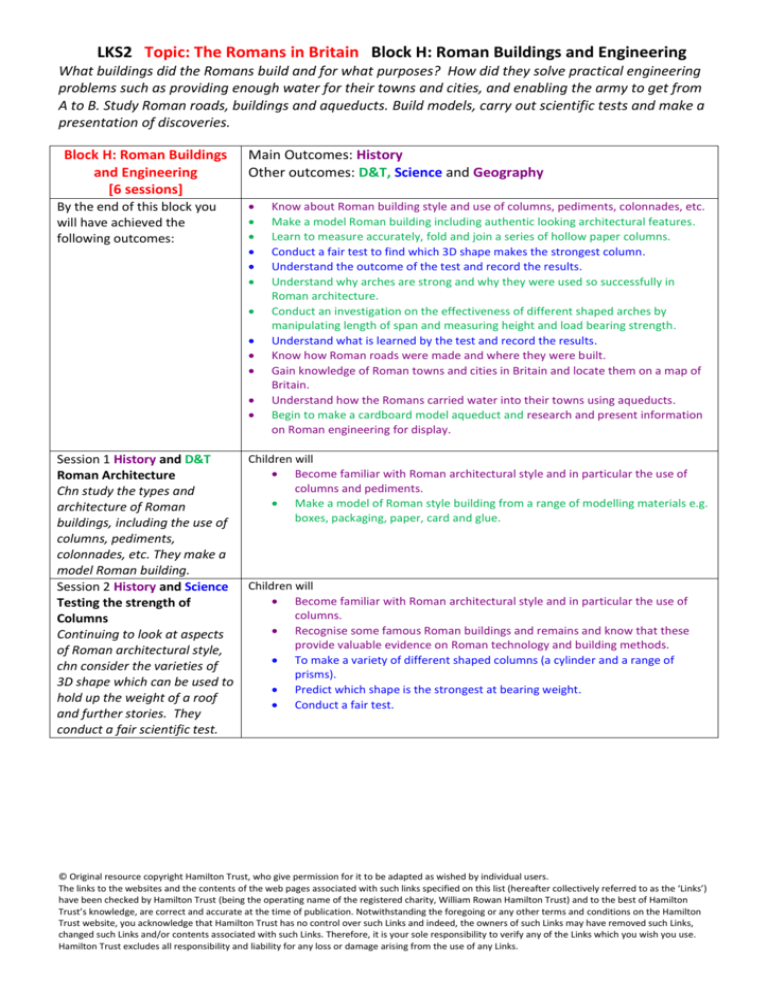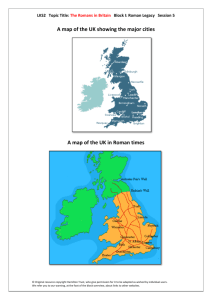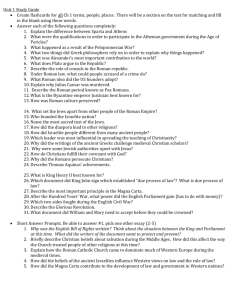Block Outcomes - Hamilton Trust
advertisement

LKS2 Topic: The Romans in Britain Block H: Roman Buildings and Engineering What buildings did the Romans build and for what purposes? How did they solve practical engineering problems such as providing enough water for their towns and cities, and enabling the army to get from A to B. Study Roman roads, buildings and aqueducts. Build models, carry out scientific tests and make a presentation of discoveries. Block H: Roman Buildings and Engineering [6 sessions] By the end of this block you will have achieved the following outcomes: Main Outcomes: History Other outcomes: D&T, Science and Geography Session 1 History and D&T Roman Architecture Chn study the types and architecture of Roman buildings, including the use of columns, pediments, colonnades, etc. They make a model Roman building. Session 2 History and Science Testing the strength of Columns Continuing to look at aspects of Roman architectural style, chn consider the varieties of 3D shape which can be used to hold up the weight of a roof and further stories. They conduct a fair scientific test. Know about Roman building style and use of columns, pediments, colonnades, etc. Make a model Roman building including authentic looking architectural features. Learn to measure accurately, fold and join a series of hollow paper columns. Conduct a fair test to find which 3D shape makes the strongest column. Understand the outcome of the test and record the results. Understand why arches are strong and why they were used so successfully in Roman architecture. Conduct an investigation on the effectiveness of different shaped arches by manipulating length of span and measuring height and load bearing strength. Understand what is learned by the test and record the results. Know how Roman roads were made and where they were built. Gain knowledge of Roman towns and cities in Britain and locate them on a map of Britain. Understand how the Romans carried water into their towns using aqueducts. Begin to make a cardboard model aqueduct and research and present information on Roman engineering for display. Children will Become familiar with Roman architectural style and in particular the use of columns and pediments. Make a model of Roman style building from a range of modelling materials e.g. boxes, packaging, paper, card and glue. Children will Become familiar with Roman architectural style and in particular the use of columns. Recognise some famous Roman buildings and remains and know that these provide valuable evidence on Roman technology and building methods. To make a variety of different shaped columns (a cylinder and a range of prisms). Predict which shape is the strongest at bearing weight. Conduct a fair test. © Original resource copyright Hamilton Trust, who give permission for it to be adapted as wished by individual users. The links to the websites and the contents of the web pages associated with such links specified on this list (hereafter collectively referred to as the ‘Links’) have been checked by Hamilton Trust (being the operating name of the registered charity, William Rowan Hamilton Trust) and to the best of Hamilton Trust’s knowledge, are correct and accurate at the time of publication. Notwithstanding the foregoing or any other terms and conditions on the Hamilton Trust website, you acknowledge that Hamilton Trust has no control over such Links and indeed, the owners of such Links may have removed such Links, changed such Links and/or contents associated with such Links. Therefore, it is your sole responsibility to verify any of the Links which you wish you use. Hamilton Trust excludes all responsibility and liability for any loss or damage arising from the use of any Links. LKS2 Topic: The Romans in Britain Block H: Roman Buildings and Engineering Session 3 History and Science Children will Roman Arches Become familiar with Roman architectural style and in particular the use of arches and why they are so strong. Why did the Romans use so Learn how forces act on arches and post and lintel style bridges. many arches? Chn conduct an Investigate the strength of different shaped arches developing skills of investigation on effectiveness measuring, fair testing and collaboration. of different shaped arches by manipulating length of span and measuring height and load bearing strength. Children will Session 4 History and Geography Gain knowledge of how the Romans built roads Roman Roads Know the legacy of the Romans on our roads and place names. Chn learn how Roman roads Know the location of a number of different towns and cities across Britain that have historical Roman significance. were made and where they were built. They place Roman towns and cities on a map of Britain Children will Session 5 History and D&T Roman Aqueducts Learn about the construction and use of Roman aqueducts to bring fresh water into the towns and cities and to research and display information on Roman Understanding how the engineering. Romans carried water using Begin to make a class model of an aqueduct using paper engineering skills to aqueducts, chn begin to construct arches. make a cardboard model aqueduct. Children will Session 6 History and D&T To continue learning about Roman engineering. Finishing the model Research and display information on famous aqueducts. Aqueduct To finish the class model of an aqueduct by modelling the background scenery Chn complete their model and make a channel above the arches to carry marbles slowly downwards as a aqueduct and prepare and real one would carry water. present information on Roman architecture. Resources Session 1 Provided: PowerPoint of Roman Columns. You will need: 3 or 4 cylinders (one from your 3D shape collection and some from everyday packaging, e.g. a can of soup, a tube of crisps, a kitchen roll); A large range of assorted cardboard packaging, e.g. cereal packets, chocolate boxes, cartons (lots of shapes and sizes); Large sheets of card; Some triangular “pediments” of different sizes, cut from thick cardboard boxes (with a craft knife) prior to the lesson (see slide 7); PVA glue and glue spreaders; Plenty of A4 and A5 paper for columns; Glue sticks; Pencils; Rulers; Right angle triangles of thin card to strengthen pediments (see slide 8); Acrylic paint in pale stone colours; Thick brushes. © Original resource copyright Hamilton Trust, who give permission for it to be adapted as wished by individual users. The links to the websites and the contents of the web pages associated with such links specified on this list (hereafter collectively referred to as the ‘Links’) have been checked by Hamilton Trust (being the operating name of the registered charity, William Rowan Hamilton Trust) and to the best of Hamilton Trust’s knowledge, are correct and accurate at the time of publication. Notwithstanding the foregoing or any other terms and conditions on the Hamilton Trust website, you acknowledge that Hamilton Trust has no control over such Links and indeed, the owners of such Links may have removed such Links, changed such Links and/or contents associated with such Links. Therefore, it is your sole responsibility to verify any of the Links which you wish you use. Hamilton Trust excludes all responsibility and liability for any loss or damage arising from the use of any Links. LKS2 Topic: The Romans in Britain Block H: Roman Buildings and Engineering Session 2 Provided: PowerPoint of Instructions on making columns. You will need: 3 or 4 cylinders (one from your 3D shape collection and some from everyday packaging); A box of 3D shapes including a number of prisms (triangular, cuboid, pentagonal, hexagonal, octagonal); Plenty of A4 paper; Glue sticks; Sharp pencils; Rulers; Flip chart; Pens; Calculators; A large number of each of the following metric weights; 100g, 200g, 500g and 1kg. Session 3 Provided: PowerPoint on Roman Arches; Worksheet - 1 per child. You will need: Sheets of A3 card (or thick paper, e.g. sugar paper); A large number of books (to make columns); Small play people (or other non-standard unit of weight, e.g. multilink). Session 4 Provided: PowerPoint presentation on Roman roads; Outline map of England printed on A3 (1 per child in medium/ hard group); Task prompt sheet (top part easy group, lower part medium/ hard group). You will need: Atlases/ road maps of Britain; A3 Printed road map of Britain showing major towns and cities (photocopy this from Atlas/road map to A3 size (1 per child in easy group)); Highlighter pens; Pens; Rulers; Flip chart with pens; Individual whiteboards and pens. Session 5 Provided: PowerPoint on Roman Aqueducts; Questions for research printed and cut. You will need: A long cardboard tube (can be made with a rolled sheet of A1 paper held with a rubber band) and a marble; 2 large cardboard boxes with the fronts cut away (see PowerPoint); 8-10 strips of card 40cm x 10cm (for the arches); Other white card strips; 16-20 small cardboard rolls (see PowerPoint) and an equal number of paper rectangles to cover them; Pencils; Rulers; PVA glue with spreaders; Paper; Pens; Colouring pencils; Access to computers (or printouts of web pages); Reference books. Session 6 Provided: PowerPoint on Famous Roman Aqueducts; Task prompt sheet. You will need: Half-finished class model aqueduct; Acrylic paints; PVA glue; Brushes; Mixing pallets; Pencils; Rulers; Coloured crayons; Kitchen roll and Cling film; 2 strips of thin card 10cm wide as long as the aqueduct (or several shorter strips that together make up the length with a 2cm overlap for each join); A4 card; Pens; Access to computers and the internet (or reference books and printouts). © Original resource copyright Hamilton Trust, who give permission for it to be adapted as wished by individual users. The links to the websites and the contents of the web pages associated with such links specified on this list (hereafter collectively referred to as the ‘Links’) have been checked by Hamilton Trust (being the operating name of the registered charity, William Rowan Hamilton Trust) and to the best of Hamilton Trust’s knowledge, are correct and accurate at the time of publication. Notwithstanding the foregoing or any other terms and conditions on the Hamilton Trust website, you acknowledge that Hamilton Trust has no control over such Links and indeed, the owners of such Links may have removed such Links, changed such Links and/or contents associated with such Links. Therefore, it is your sole responsibility to verify any of the Links which you wish you use. Hamilton Trust excludes all responsibility and liability for any loss or damage arising from the use of any Links.






